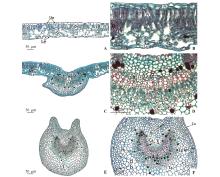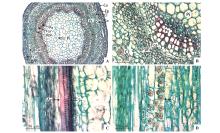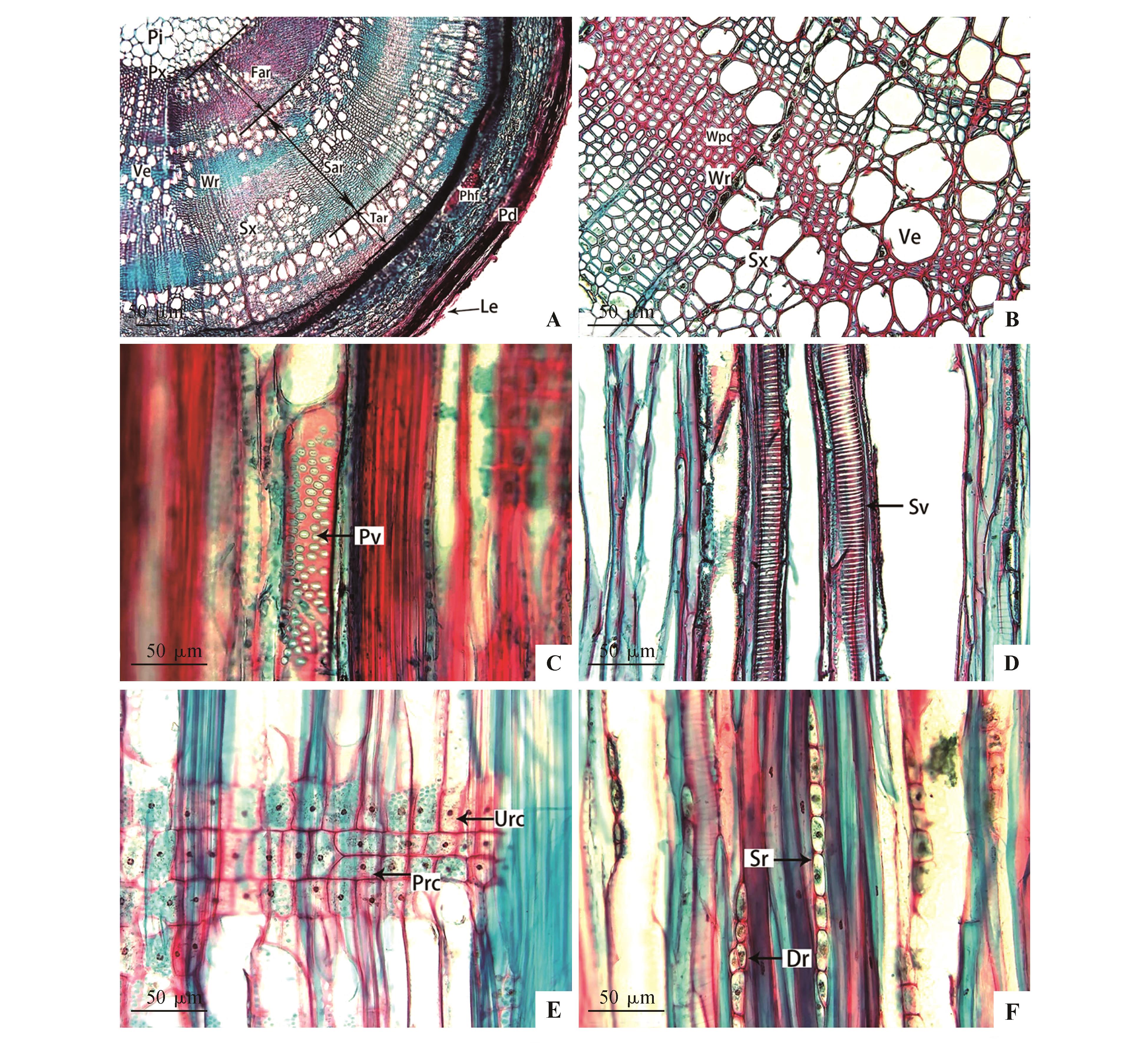Bulletin of Botanical Research ›› 2023, Vol. 43 ›› Issue (3): 461-469.doi: 10.7525/j.issn.1673-5102.2023.03.016
• Plant reproductive biology • Previous Articles Next Articles
Qingsong WU, Yinghui LIU, Shuo LI, Panpan LI, Youmin ZHANG( )
)
Received:2022-10-03
Online:2023-05-20
Published:2023-05-11
Contact:
Youmin ZHANG
E-mail:1005478530@qq.com
About author:WU Qingsong(1995—),male,master degree candidate,major in plant morphology and anatomy.
Supported by:CLC Number:
Qingsong WU, Yinghui LIU, Shuo LI, Panpan LI, Youmin ZHANG. Anatomical Structure and Ecological Adaptability of Stems and Leaves of Rhamnus ussuriensis[J]. Bulletin of Botanical Research, 2023, 43(3): 461-469.
Add to citation manager EndNote|Ris|BibTeX
URL: https://bbr.nefu.edu.cn/EN/10.7525/j.issn.1673-5102.2023.03.016

Fig.3
Anatomical structure of R. ussuriensis leafA.Anatomical structure on both sides of leaf midvein;B.Anatomical structure on both sides of leaf midvein;C.Anatomical structure of leaf main vein;D.Anatomical structure of leaf main vein;E.The outline of petiole transverse section;F.Vascular bundle morphology on petiole transverse section;Ue.Upper epidermis;Pt.Palisade tissue;St.Spongy tissue;Le.Lower epidermis;Me.Mesophyll;Mt.Mechanical tissue;Gt.Ground tissue;X.Xylem;Ca.Cambium;Ph.Phloem;Ta.Tannins;Cl.Cluster;Cu.Cuticles;Ep.Epidermis;Mc.Mucous cells;Is.Intercellular space


Fig.4
Anatomy of primary stem of Rh. ussuriensisA-B.Transverse section of primary stem;C-D.Primary stem longitudinal section;Cu.Cuticles;Ep.Epidermis;Co.Cortex;Col.Collenchyma;Cpc.Cortical parenchyma cells;Vc.Vascular cylinder;Cl.Cluster;Pph.Primary phloem;Fca.Fascicular cambium;Px.Primary xylem;Pi.Pith;Av.Annular vessel;Sv.Spiral vessel


Fig.5
Anatomical structure of secondary stems of Rh. ussuriensisA-B.Transverse section of secondary stem;C-D.Longitudinal section of secondary stem;E.Longitudinal section of secondary stem;F.Secondary stem tangential section;Le.Lenticel;Pd.Periderm;Phf.Phloem fiber;Sx.Secondary xylem;Ve.Vessel;Wr.Wood ray;Px.Primary xylem;Pi.Pith;Far.First annual ring;Sar.Second annual ring;Tar.Third annual ring;Wpc.Wood parenchyma cells;Pv.Pitted vessel;Sv.Spiral vessel;Prc.Procumbent ray cell;Urc.Upright ray cell;Dr.Double ray;Sr.Single ray

| 1 | 中国科学院中国植物志编辑委员会.中国植物志:第48卷:鼠李科[M].北京:科学出版社,1982:23-88. |
| Editorial Committee of Chinese Flora, Chinese Academy of Sciences.Flora of China:Vol.48:Rhamnaceae[M].Beijing:Science Press,1982:23-88. | |
| 2 | 刘洋.呼和浩特地区引种园林植物综合评价及繁殖特性研究[D].呼和浩特:内蒙古农业大学,2021. |
| LIU Y.Study on comprehensive evaluation and propagation characteristics of introduced landscape plants in hohhot[D].Hohhot:Inner Mongolia Agricultural University,2021. | |
| 3 | 张爽,潘伟,卞思达,等.申家店林区野生木本植物种类调查及园林应用建议[J].现代化农业,2014(12):27-28. |
| ZHANG S, PAN W, BIAN S D,et al.Investigation on species of wild woody plants in shenjiadian forest area and suggestions on garden application[J].Modernizing Agriculture,2014(12):27-28. | |
| 4 | 李红杰,魏薇,丁泊遥.九峰山自然保护区野生花灌木筛选及评价[J].北方园艺,2011(20):104-110. |
| LI H J, WEI W, DING B Y.Screening and evaluation of wild flowers and shrubs in Jiufeng Mountain Nature Reserve[J].Northern Horticulture,2011(20):104-110. | |
| 5 | 魏薇.浑善达克沙地野生花灌木筛选及其园林应用评价[D].呼和浩特:内蒙古农业大学,2009. |
| WEI W.Screening of the Wild Flowering shrubs in the hunshandake sand and evaluation of landscape application[D].Hohhot:Inner Mongolia Agricultural University,2009. | |
| 6 | 胡海清,刘菲.30种树叶的点燃含水率与蔓延含水率[J].林业科学,2006(11):81-86. |
| HU H Q, LIU F.The ignition moisture content and spread moisture content for leaves of 30 tree species[J].Scientia Silvae Sinicae,2006(11):81-86. | |
| 7 | 赵一之,王光辉.乌苏里鼠李的名实问题[J].植物研究,2005(1):11-13. |
| ZHAO Y Z, WANG G H.The Identity of Rhamnus ussuriensis J.Vass[J].Bulletin of Botanical Research,2005(1):11-13. | |
| 8 | 刘洋,郭娇,王娟,等.乌苏里鼠李种子休眠机理及萌发特性研究[J].西北农林科技大学学报(自然科学版),2020,48(12):127-135. |
| LIU Y, GUO J, WANG J,et al.Seed dormancy mechanism and germination characteristics of Rhamnus ussuriensis [J].Journal of Northwest A & F University(Natural Science Edition),2020,48(12):127-135. | |
| 9 | 林阳,王世忠,于欣.截干高度对乌苏里鼠李枝条萌发效果的影响[J].防护林科技,2019(9):1-3,7. |
| LIN Y, WANG S Z, YU X.Effects of truncation heights on shoot germination of Rhamnus ussuriensis [J].Protection Forest Science and Technology,2019(9):1-3,7. | |
| 10 | 金光德,南桂仙,玄哲荣.不同提取条件对乌苏里鼠李果红色素浸提效果的影响[J].安徽农业科学,2011,39(36):22301-22302. |
| JIN G D, NAN G X, XUAN Z Y.The influence of the different extraction conditions on the relative extraction rate of red pigment from the fruits of Rhamnus [J].Journal of Anhui Agricultural Sciences,2011,39(36):22301-22302. | |
| 11 | 余湘云,刘晓玲,李秀芬,等.山西省的鼠李属植物[J].山西大学学报(自然科学版),1996(4):99-102. |
| YU X Y, LIU X L, LI X F,et al.Taxa of Rhamnus from Shanxi Province [J].Journal of Shanxi University(Natural Science Edition),1996(4):99-102. | |
| 12 | 闫翠香,邵小明,丁新泉,等.掌叶覆盆子营养器官解剖结构及其特征分析[J].北方园艺,2015(20):134-138. |
| YAN C X, SHAO X M, DING X Q,et al.Anatomical structure characters of vegetative organs of Rubus chingii [J].Northern Horticulture,2015(20):134-138. | |
| 13 | 李蒙蒙,刘丹,刘玉冰.基于叶片微形态结构评价10种锦鸡儿属(Caragana)植物的抗旱特征[J].中国沙漠,2016,36(3):708-717. |
| LI M M, LIU D, LIU Y B.Evaluation on drought-resistant characteristics of ten Caragana species based on leaf micromorphological structure[J].Journal of Desert Research,2016,36(3):708-717. | |
| 14 | 沈萩荻,吴艳,刘利,等.6个种源地不同桑树品种叶柄解剖结构与水分运输能力初探[J].蚕业科学,2019,45(1):1-8. |
| SHEN Q D, WU Y, LIU L,et al.A Preliminary study on anatomical characteristics and water transporting capacity of petioles from six varieties originated from different habitations[J].Acta Sericologica Sinica,2019,45(1):1-8. | |
| 15 | 赵君茹,朱周俊,肖诗鑫,等.高州油茶无性系叶片解剖结构及抗旱性评价[J].分子植物育种,2022,20(16):5435-5443. |
| ZHAO J R, ZHU Z J, XIAO S X,et al.Drought resistance evaluation and leaf anatomical structure of Camellia gauchowensis Chang Clone[J].Molecular Plant Breeding,2022,20(16):5435-5443. | |
| 16 | 陈模舜,柯世省.濒危植物夏蜡梅营养器官的解剖结构特征[J].植物资源与环境学报,2010,19(3):37-41. |
| CHEN M S, KE S S.Anatomical structure characteristics of vegetative organs of endangered plant Calycanthus chinensis [J].Journal of Plant Resources and Environment,2010,19(3):37-41. | |
| 17 | 蒋迎红,刘雄盛,蒋燚,等.濒危植物海南风吹楠营养器官解剖结构特征[J].广西植物,2018,38(7):843-850. |
| JIANG Y H, LIU X S, JIANG Y,et al.Anatomical structure characteristics of vegetative organs of endangered plant Horsfieldia hainanensis [J].Guihaia,2018,38(7):843-850. | |
| 18 | 李正理.植物制片技术[M].北京:科学出版社,1987:138-148. |
| LI Z L.Plant slicing technology[M].Beijing:Science Press,1987:138-148. | |
| 19 | 王玉,赵虎,洑香香.青钱柳营养器官的解剖结构及其生态适应性[J].东北林业大学学报,2011,39(10):40-44. |
| WANG Y, ZHAO H, FU X X.Anatomical structures of vegetative organs of Cyclocarya paliurus and its ecological adaptability[J].Journal of Northeast Forestry University[J].2011,39(10):40-44. | |
| 20 | 康健,李胜男,田嘉,等.橡胶草及其同属植物叶表皮形态特征的研究[J].新疆农业大学学报,2017,40(5):313-319. |
| KANG J, LI S N, TIAN J,et al.Study on leaf epidermis characteristics of Taraxacumkok-saghyz and its relative species[J].Journal of Xinjiang Agricultural University, 2017,40(5):313-319. | |
| 21 | GUAN Z J, ZHANG S B, GUAN K Y,et al.Leaf anatomical structures of Paphiopedilum and Cypripedium and their adaptive significance[J].Journal of Plant Research,2011,124(2):289-298. |
| 22 | ASHTON P M S, BERLYN G P.Leaf Adaptations of some Shorea species to sunand shade[J].New Phytologist,1992,121(4):587-596. |
| 23 | 何凤,杜红岩,刘攀峰,等.干旱胁迫对杜仲叶片结构特征的影响[J].植物研究,2021,41(6):947-956. |
| HE F, DU H Y, LIU P F,et al.Effects of drought stress on leaf structure of Eucommia ulmoides [J].Bulletin of Botanical Research, 2021,41(6):947-956. | |
| 24 | 任哲,贡翔,张锐,等.扁桃优株叶片解剖结构与其抗旱性关系研究[J].农业与技术,2022,42(3):10-14. |
| REN Z, GONG X, ZHANG R,et al.Study on the relationship between leaf anatomical structure and drought resistance of high quality Amygdalus communis [J].Agriculture and Technology,2022,42(3):10-14. | |
| 25 | 王爽,侯毅兴,冯琳骄,等.干旱胁迫对鲜食葡萄叶片解剖结构的影响[J/OL].中国农业科技导报:1-10[2022-08-21]. |
| WANG S, HOU Y X, FENG L J,et al.Effect of drought stress on the anatomical structure of leaves in table grape varieties[J/OL].Journal of Agricultural Science and Technology:1-10[2022-08-21]. | |
| 26 | 潘昕,邱权,李吉跃,等.基于叶片解剖结构对青藏高原25种灌木的抗旱性评价[J].华南农业大学学报,2015,36(2):61-68. |
| PAN X, QIU Q, LI J Y,et al.Drought resistance evaluation based on leaf anatomical structures of 25 shrubs on the tibetan plateau[J].Journal of South China Agricultural University,2015,36(2):61-68. | |
| 27 | 张金玲,李玉灵,庞梦丽,等.臭柏异形叶解剖结构及其抗旱性的比较[J].西北植物学报,2017,37(9):1756-1763. |
| ZHANG J L, LI Y L, PANG M L,et al.comparison of drought resistance of anatomical structure in the heterophylly Mechanism of Sabina vulgaris [J].Acta Botanica Boreali-Occidentalia Sinica,2017,37(9):1756-1763. | |
| 28 | 许少祺,刘浩地,李雪,等.两种野豌豆属植物叶片形态结构及其生态适应性研究[J].东北农业大学学报,2021,52(3):26-33. |
| XU S Q, LU H D, LI X,et al.Study on leaf morphological structures of two species in Vicia and relation with ecological adaptability[J].Journal of Northeast Agricultural University,2021,52(3):26-33. | |
| 29 | 陈燕,刘锴栋,黎海利,等.5种红树植物的叶片结构及其抗逆性比较[J].东北林业大学学报,2014,42(7):27-31,68. |
| CHEN Y, LIU K D, LI H L,et al.Leaf stuctures and stress resistance in five mangrove species[J].Journal of Northeast Forestry University,2014,42(7):27-31,68. | |
| 30 | 陈健辉,缪绅裕,黄丽宜,等.海桑和无瓣海桑叶片结构的比较研究[J].植物科学学报,2015,33(1):1-8. |
| CHEN J H, MIAO S Y, HUANG L Y,et al.Comparative study on the leaf structures of Sonneratia caseolaris and S. apetala [J].Plant Science Journal, 2015,33(1):1-8. | |
| 31 | 管东旭,冯春慧,田昆,等.纳帕海湖滨带优势植物杉叶藻(Hippuris vulgaris)茎解剖结构对模拟增温的响应[J].生态学杂志,2019,38(6):1620-1628. |
| GUAN D X, FENG C H, TIAN K,et al.Responses of stem anatomical structure of a lakeside dominant plant Hippuris vulgaris to simulated warming in napahai wetland[J].Chinese Journal of Ecology,2019,38(6):1620-1628. | |
| 32 | 高艳,崔洪霞,石雷,等.丁香属植物叶片表皮形态特征与环境适应及系统学关联[J].西北植物学报,2008(3):475-484. |
| GAO Y, CUI H X, SHI L,et al.Characteristics of leaf epidermis of Syringa and the association with their environmental adaptation and systematics[J].Acta Botanica Boreali-Occidentalia Sinica,2008(3):475-484. | |
| 33 | 王孟珂,田梦妮,毕泉鑫,等.基于气孔性状的文冠果种质资源抗旱性评价及抗旱资源筛选[J].植物研究,2021,41(6):957-964. |
| WANG M K, TIAN M N, BI Q X,et al.Evaluation of drought tolerance based on stomatal characters and selection of germplasm resources from Xanthoceras sorbifolia [J].Bulletin of Botanical Research,2021,41(6):957-964. | |
| 34 | 尤凤丽,曲丽娜,胡敏,等.委陵菜属植物叶表皮微形态及其与环境关系[J].安徽农业科学,2010,38(23):12424-12426,12451. |
| YOU F L, QU L N, HU M,et al.Leaf epidermis micromorphology of potentilla and its relationship with environment[J].Journal of Anhui Agricultural Sciences,2010,38(23):12424-12426,12451. | |
| 35 | 胡云,燕玲,李红.14种荒漠植物茎的解剖结构特征分析[J].干旱区资源与环境,2006(1):202-208. |
| HU Y, YAN L, LI H.Studies on the Anatomical characteristics of the stems of 14 desert plants[J].Journal of Arid Land Resources and Environment,2006(1):202-208. | |
| 36 | 张般般,刘婷,杨静慧,等.4个树莓品种茎解剖结构与抗旱性的关系[J].西南大学学报(自然科学版),2018,40(5):53-58. |
| ZHANG B B, LIU T, YANG J H,et al.The relationship between stem anatomical structureand drought resistance in 4 varieties of raspberry[J].Journal of Southwest University(Natural Science Edition),2018,40(5):53-58. | |
| 37 | 钱雪,张友民,张达维,等.丁香属植物红丁香解剖结构及其抗旱适应性[J].北方园艺,2017(8):70-75. |
| QIAN X, ZHANG Y M, ZHANG D W,et al.Anatomical structure and drought adaptability of the Syringa villosa vahl of genus Syringa [J].Northern Horticulture,2017(8):70-75. | |
| 38 | 滕丽,王晓茹,赵桂仿,等.桃儿七营养器官解剖结构的地理差异[J].西北植物学报,2009,29(4):768-774. |
| TENG L, WANG X R, ZHAO G F,et al.Comparison anatomy of vegetative organ of Sinopodophyllum emodi in different populations[J].Acta Botanica Boreali-Occidentalia Sinica,2009,29(4):768-774. | |
| 39 | 黄萍,沈俊辉,顾东亚,等.小花山桃草营养器官解剖结构及其生态适应性研究[J].植物研究,2009,29(4):397-401. |
| HUANG P, SHEN J H, GU D Y,et al.Anatomical structures of vegetative organs and ecological adaptation of Gaura parviflora [J].Bulletin of Botanical Research,2009,29(4):397-401. | |
| 40 | 上官方京,赵明水,张博纳,等.亚热带植物水力性状与木质部解剖结构的关系[J].浙江农林大学学报,2022,39(2):252-261. |
| SHANGGUAN F J, ZHAO M S, ZHANG B N,et al.Relationship between hydraulic properties and xylem anatomical structure of subtropical plants[J].Journal of Zhejiang A&F University,2022,39(2):252-261. |
| [1] | Zhuanzhuan JIANG, Li GONG, Yaling SONG. The Chloroplast Division Protein PARC6 Affected the Growth of Cotyledon and Leaf in Arabidopsis thaliana [J]. Bulletin of Botanical Research, 2023, 43(5): 700-710. |
| [2] | Ying KANG, Jingjing PAN, Jianhua CHEN, Quangang LIU, Shengjun DONG. Contents of Pigments and Anatomical Structure of Leaves in Acer negundo ‘Aurea’ [J]. Bulletin of Botanical Research, 2023, 43(4): 591-600. |
| [3] | Qiongyue LIANG, Changqiu LIU, Qifeng LU, Tao DENG, Bo CAI. The Pollination Biology of Begonia Guangxiensis, a Narrowly Distributed Species [J]. Bulletin of Botanical Research, 2023, 43(3): 432-438. |
| [4] | Qin TIAN, Chengyan SHAO, Hanning DUAN, Chenxuan YANG, Lu LI. Morph-anatomy of Leaf and Taxonomic Insights of Eight Viola species from Yunnan,China [J]. Bulletin of Botanical Research, 2023, 43(3): 447-460. |
| [5] | Tingting LI, Liu YANG, Xiaoxia LI, Yisong WANG, Xiuwei WANG. Different Nitrogen Forms on the Photosynthetic Characteristics and Growth of Fraxinus mandshurica and Quercus mongolica [J]. Bulletin of Botanical Research, 2023, 43(2): 207-217. |
| [6] | Yang LIU, Liying XU, Tongchao WEI, Lanyi SHEN, Dounan LIU, Yue LIU. Response of Leaf Functional Traits and their relationships to Seasonal Changes in Four Acer Species [J]. Bulletin of Botanical Research, 2023, 43(2): 242-250. |
| [7] | Changrui TAI, Kai ZHAO, Yanfang YANG, Yan WU, Wei ZHAI, Yuewei TONG. Flowering Biological Characteristics and Breeding System of the Rare and Endangered Plant of Sinojackia microcarpa [J]. Bulletin of Botanical Research, 2023, 43(2): 311-320. |
| [8] | Jun SUN, Guisheng LI. Sequencing and Analysis of miRNAs in Vegetative and Reproductive Growths of Ceratopteris pteridoides [J]. Bulletin of Botanical Research, 2022, 42(6): 1014-1022. |
| [9] | Xiaolu CAO, Qiaozhu ZHAO, Hua XING, Mengfei LI. Anatomical Structure of Seed and Morphological Character at Different Germination Stages of Sinopodophyllum hexandrum [J]. Bulletin of Botanical Research, 2022, 42(5): 746-752. |
| [10] | Mengqiao GUO, Xuanyu CHEN, Senrong HONG, Jiao LI, Jie FAN, Xinyu CHENG. The Correlation Between Leaf Phenotype Diversity and Total Flavonoids Content of Overground Part of Tetrastigma hemsleyanum Diels & Gilg [J]. Bulletin of Botanical Research, 2022, 42(5): 876-885. |
| [11] | Weiwei ZHUANG, Mingming WANG. Comparative Analysis of Nutrient Elements of Eight Herbaceous Plants in Desert Area [J]. Bulletin of Botanical Research, 2022, 42(5): 896-909. |
| [12] | Tian SHI, Zhongmei MO, Min WU, Cai ZHAO. Phylogeography of Medicinal and Edible Homologous Plant Allium macrostemon [J]. Bulletin of Botanical Research, 2022, 42(4): 574-583. |
| [13] | Wenjing WANG, Hongfan CHEN, Guojun SHAO, Hong LIAO, Jianli ZHAO, Qingjun LI. Nectary Structure of Selfing and Outcrossing Speciesin Roscoea [J]. Bulletin of Botanical Research, 2022, 42(3): 364-372. |
| [14] | Bin WEI, Yi LI, Shiping SU. The Effect of Exogenous Proline on the Stomata of Nitraria tangutorum Leaves under Natural Drought [J]. Bulletin of Botanical Research, 2022, 42(3): 492-501. |
| [15] | Kailin Zhu, Jiabao Li, Xin Chen. Leaf Anatomical Characteristics and Environmental Adaptability of Seven Sorbus Species at Longcanggou National Forest Park [J]. Bulletin of Botanical Research, 2022, 42(2): 174-183. |
| Viewed | ||||||
|
Full text |
|
|||||
|
Abstract |
|
|||||